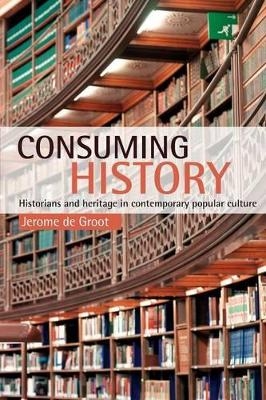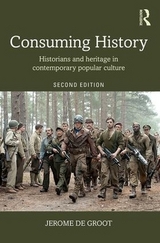
Consuming History
Routledge (Verlag)
978-0-415-39945-6 (ISBN)
- Titel erscheint in neuer Auflage
- Artikel merken
Non-academic history – `public history’ – is a complex, dynamic entity which impacts on the popular understanding of the past at all levels.
In Consuming History, Jerome de Groot examines how society consumes history and how a reading of this consumption can help us understand popular culture and issues of representation. This book analyzes a wide range of cultural entities – from computer games to daytime television, from blockbuster fictional narratives such as Da Vinci Code to DNA genealogical tools – to analyze how history works in contemporary popular culture.
Jerome de Groot probes how museums have responded to the heritage debate and the way in which new technologies have brought about a shift in access to history, from online game playing to internet genealogy. He discusses the often conflicted relationship between `public’ and academic history, and raises important questions about the theory and practice of history as a discipline.
Whilst mainly focussing on the UK, the book also compares the experiences of the USA, France and Germany. Consuming History is an important and engaging analysis of the social consumption of history and offers an essential path through the debates for readers interested in history, cultural studies and the media.
Jerome de Groot teaches at the University of Manchester. He is the author of Royalist Identities (2004) and numerous articles on popular history, manuscript culture and the English civil war.
Acknowledgements. Images. Introduction: History and popular culture. The prizewinning past. Selling historically. Desiring history. Historiocopia/Historioglossia. The popular historian. `Public’ history 1. The public historian, the historian in public. The `new gardening’ and the publicity historian. History, historians, historiography, and celebrity: Great Britons. `I consider any kind of political or emotional pity for this man is out of place’: the David Irving libel trial and aftermath 2. Popular history in print. Narrative History. Political Diaries and witness accounts. Autobiography, personal memoir and biography. Historical biography. The past for children: Horrible Histories. The status of the popular history author. Popular circulation: Magazines. Reception and consumption: Reading Groups and reader-reviews 3. The historian in popular culture. `That’s you, that is’: historian as child, adventurer, and hero. The Da Vinci Code. Enfranchisement, ownership and consumption: `amateur’ histories. Serious leisure and enfranchisement 4. Objects and artefacts: antiques, metal detectors and popular archaeology. Local History. The everyday historical: local history, antiques, metal detecting. Metal Detecting, popular archaeology, treasure hunting. History as Hobby: Collecting and Antiquing. Antiques on television: Antiques Roadshow, Flog It!, Bargain Hunt 5. Genealogy: leisure, politics, science. Genealogy. `I’m getting more and more Jewish as this goes on’: self-identity and celebrity revelation. Roots, identity genealogy and America. Science: Genetic Genealogy and daytime detection 6. Digital History: archives, information architecture, encyclopaedias, community websites and search engines. New sources, new tools, new archives. Networked interfaces with information: search engines, Wikipedia. Hacking history: Google Earth. Open source code and community websites. Performing and playing history. Seeing and Believing: Re-enactment Culture. 7. Historical Re-enactment. Combat re-enactment: NARES and the Sealed Knot. Re-enactment and place as historical evidence: documentary. Getting Medievalish: Anachronism, Faires and Banquets 8. Recycling culture and re-enactment/ cultural re-enactment. Music, performance, and remakes. The first time as atonement, the second time as art: Lifeline and Jeremy Deller. The `extreme historian’: Reinhabiting the past 9. History Games. First Person shoot `em up History. Role playing and history as identity. Civilization and disc contents: strategy games. Wargames and scale models. History on Television. Democratisation and deregulation. 10. Contemporary historical documentary. Documentary as form: self-consciousness and diversion. `neither wholly fictional nor wholly factual’: History on television. `contemporary, lively and egalitarian’: Schama and Starkey. History on Television elsewhere. 11. Reality History. Empathy, auuthenticity and identity. Historical difference and ideology. Authenticity and the historical revelation of self. The `historical’ as cultural genre. The genres of history 12. Historical television: classic serial, costume drama and comedy. Adaptation and costume drama. Queering the genre: Tipping the Velvet and The Line of Beauty. Boy’s own authentic drama: Sharpe and Hornblower. Innovation and obscenity: Rome and Deadwood. `Good Moaning’: Comedy and time-travel 13. Performing history – Film and Drama. National cinema, international audiences and historical film. The Heritage debate and British film. History, complexity and horror: Atonement and The Wind the Shakes the Barley. 14. Imagined histories: Novels, plays and comics. Historical Novels. Graphic Novels and hybrid genres. Historical Stage Drama. Artefact and interpretation. New Theories of the Museum. 13. Museums and physical encounters with the past. New Theories of the Museum. Museums and government policy. Digitisation and economics. Conclusions
| Erscheint lt. Verlag | 20.10.2008 |
|---|---|
| Zusatzinfo | 4 Illustrations, black and white |
| Verlagsort | London |
| Sprache | englisch |
| Maße | 156 x 234 mm |
| Gewicht | 460 g |
| Themenwelt | Geschichte ► Teilgebiete der Geschichte ► Kulturgeschichte |
| ISBN-10 | 0-415-39945-9 / 0415399459 |
| ISBN-13 | 978-0-415-39945-6 / 9780415399456 |
| Zustand | Neuware |
| Haben Sie eine Frage zum Produkt? |
aus dem Bereich



